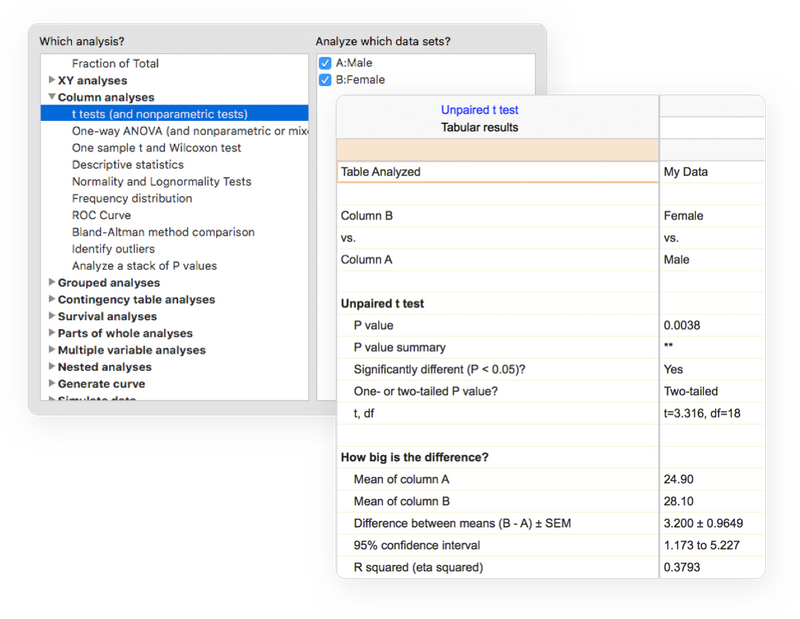

- #Graphpad prism 8 vs how to
- #Graphpad prism 8 vs windows
Two-way ANOVA can now be calculated even if there is no data for some row/column combinations (but only if you choose not to fit the interaction term). Now it can fit a main-effects only model. Previous Prism versions always fit the interaction term. Choose whether you wish to include an interaction term in the model. This plots both raw data and the effect size (difference between means) with a confidence interval. Plot the results of unpaired and paired t tests with an estimation plot. Calculate geometric means with "no errors", "geometric SD", “CI”. Calculate medians with "no errors", "quartiles", "min / max", or "percentiles". Calculate the confidence interval of mean with any confidence interval level (Prism 8 only computed 95% CI). Multiple regression and logistic regression can output a covariance matrix, and create a heat map, showing how the explanatory variables correlate with each other. The first tab of the dialog, where you define the model, has been redesigned. Interpolate outcome (dependent) variable values from data in the data table or by using specified values for each predictor in a model with multiple linear regression. Read more (multiple linear regression) or Read more (multiple logistic regression) Options available to specify the "reference level" for each categorical variable in the model. Prism automatically creates new variables ("dummy variables", one fewer than the number of levels) to use in regression. Both multiple linear and multiple logistic regression can fit a model where one (or more) predictor (independent) variable is categorical with three or more levels. Nonparametric unpaired Kolmogorov-Smirnov tests. Nonparametric unpaired Mann-Whitney tests. Now, it can also perform (one per row), these analyses: The multiple t test analysis in Prism 8 only could perform the unpaired (two-sample) t test, one per row. With Prism 9, X0 is a parameter that must be set to a constant value, but you can set it to any value in the nonlinear regression parameters dialog. In Prism 8, you could set the value of X0 when defining a user-defined differential equation. When you fit a model defined by a differential equation, one of the parameters fit is Y, the value of Y when X equals X0. User-defined equations are evaluated much more quickly (and more accurately). You can now create five residual graphs (including the new Actual vs Predicted graph). It is often used to visualize genetic distance and relatedness between populations. PCA is mostly used as a tool in exploratory data analysis and for making predictive models. For example, it could reduce a data set with 15 variables down to a data set with four components that explain most of the variability. 
It determines a number of “components” (each a linear combination of the original variables) that explain much of the variation. PCA is a method used to analyze data with many variables.You can override this automatic decision as needed. As you enter (or import) data, Prism defines each variable (column) as continuous, categorical or labels.It creates new variables (one less than the number of levels) to include in the model, using the reference level method.
#Graphpad prism 8 vs how to
Prism knows how to fit models where a categorical variable has three or more levels (possible values).Multiple and logistic regression can now fit models where one or more of the predictor (independent) variables is entered as text and designated as a categorical variable.Each variable (column) is now identified as a continuous (numeric), categorical, or label variable.You can now enter text variables into multiple variable tables.
#Graphpad prism 8 vs windows
No longer runs on 32-bit Windows, as 64-bit Windows has been standard for a decade. A data table can now have 1024 data sets and 512 sub-columns (up from 512 and 256). More data : Text variables and variable types (continuous, categorical, label) for multiple variables data tables. More data : Increased data table limits. Expanded analyses : Interpolation from Multiple Linear Regression. Expanded analyses : New options for Multiple t test analyses (paired, nonparametric, and more). New Graphs : Actual vs Predicted plot from nonlinear regression. New Graphs : Estimation plots automatically generated from t tests. New Graphs : Bubble plots and other multiple variables graphs from multiple variables data tables. More automation : Automatically add multiple comparison results to graphs ("Stars on Graph").  New analyses : Principal Component Analysis (PCA) and Principal Component Regression (PCR). If you have large data tables, you’ll also notice that Prism runs more quickly. You’ll just see more options in many places. If you are accustomed to Prism 8, you’ll find it easy to switch to Prism 9.
New analyses : Principal Component Analysis (PCA) and Principal Component Regression (PCR). If you have large data tables, you’ll also notice that Prism runs more quickly. You’ll just see more options in many places. If you are accustomed to Prism 8, you’ll find it easy to switch to Prism 9.







 0 kommentar(er)
0 kommentar(er)
